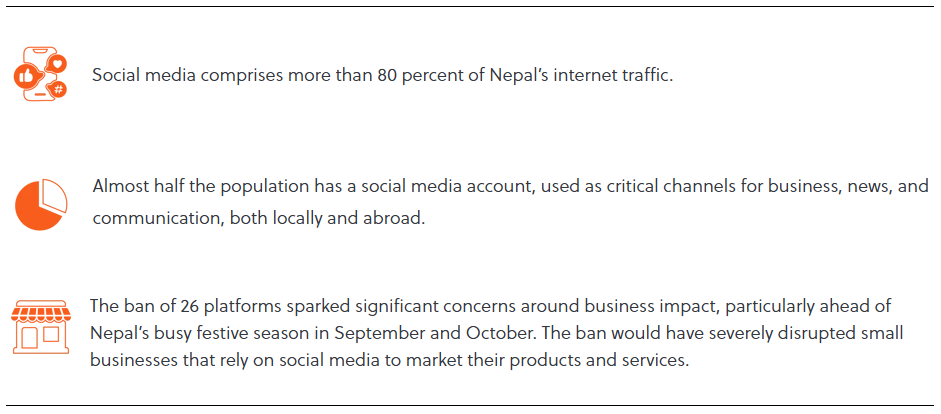Generational accountability: A youth-led insurrection in Nepal
Over two days in early September, mass anti-government unrest engulfed Nepal. Protests soon turned violent, and with at least 72 people killed and hundreds injured, the movement ultimately resulted in the collapse of the country’s government. Initially triggered by the government’s decision to ban 26 social media platforms for failing to comply with registration requirements – a move that many saw as an effort to clamp down on brewing anti-government sentiment – demonstrations soon grew to encompass broader grievances around corruption, nepotism among elite, and poor socio-economic conditions. Protesters – led mostly by youth under the age of 30 and unaligned with any political party – targeted symbols of the wealthy and political elite, vandalising and burning hundreds of government buildings, political offices, and politicians’ homes (most notably setting fire to the parliament building in Kathmandu). Several privately owned businesses and high-end residential properties, too, sustained significant damage during incidents of looting, vandalism, and arson, with total losses estimated at more than USD 250 million. A newly built five-star hotel in Kathmandu alone reported damages worth USD 83 million.

On 9 September, the second day of unrest, Prime Minister Khadga Prasad Sharma Oli resigned and an interim government was appointed to lead the country until the next general election, scheduled for March 2026. Anti-government demonstrations have since diminished following youth representatives playing an integral role in the appointment of interim Prime Minister Sushila Karki, a former chief justice reputed for her anti-corruption efforts. However, Nepal’s interim leaders – soon followed by those elected in March – will face steep challenges in addressing the country’s endemic issues, sustaining the likelihood of further unrest and political instability over the coming year.
Economic strain and systemic corruption
Many of Nepal’s economic indicators have improved in recent years; the country’s GDP grew from 3.7 in FY 2024 to 4.6 in 2025, driven by hydropower, industrial, and agricultural output, while poverty levels have markedly decreased over several decades, from 21 percent in 2010 to less than 3 percent in 2022. However, Nepal’s economy remains severely constrained by deep-seated structural issues. Nepal is heavily reliant on foreign remittances, for example, accounting for 25 percent of the country’s GDP. While remittances have played an important role in alleviating poverty, the country’s overreliance has stunted domestic job creation, and left Nepal vulnerable to external shocks and shifts in other countries’ migration policies. Domestic employment growth is further limited by the country’s complex and uncertain business environment, high levels of corruption, and insufficient infrastructure. Unemployment is particularly prevalent among the youth, surpassing 22 percent in 2023, one of the highest rates in the South Asian region.
Wealth distribution is consequently severely skewed, concentrated among the country’s political elite, with this dynamic further exacerbated by endemic corruption and nepotism. Leaders from across Nepal’s political spectrum – including several former prime ministers – have been implicated in high-profile corruption cases, ranging from preferential contracts and appointments, illegal and controversial purchases, bribery, embezzlement, and smuggling. Many of these cases have come to light in recent months, intensifying public distrust in the political establishment, and setting the scene for the recent unrest.
An uphill battle
Nepal’s youth activists have high expectations of interim Prime Minister Karki and her ability to initiate anti-corruption reform, given her reputation for probity during her tenure as chief justice in 2016 and 2017. However, there are major bureaucratic hurdles to addressing corruption in the country, including policy loopholes that largely exempt cabinet members from investigations. Widespread political interference facilitated by extensive patronage networks and weak judicial institutions will slow the pace of anti-corruption reform over the coming months, and popular frustration has already re-emerged over the lack of accountability. With corruption entrenched across government institutions, and across political parties, it remains to be seen whether the leaders elected in March will have the political will, or parliamentary support, to address this issue over the longer term. Similarly, the new government will need time and sufficient parliamentary support to implement the reforms required to address the country’s structural economic weaknesses. In the absence of tangible improvements over the coming year, and profound distrust in Nepal’s political establishment, the country’s youth may again choose to take to the streets.
With corruption entrenched across government institutions, and across political parties, it remains to be seen whether the leaders elected in March will have the political will, or parliamentary support, to address this issue over the longer term.
Adding to an already tense political climate is Nepal’s fractured political environment, between Maoist, Communist, pro-democracy and pro-monarchy factions, some of which have already challenged the constitutional legitimacy of the interim government. Nepal, no stranger to political instability, is likely to face further upheaval ahead of and after the March elections, as these groups seek to co-opt or undermine the September youth movement and expand their own influence. Although unrest has subsided for now, Nepal will face significant uncertainty over the coming year as youth activists try to preserve their gains, and the country’s establishment tries to preserve its patronage networks and political power.
